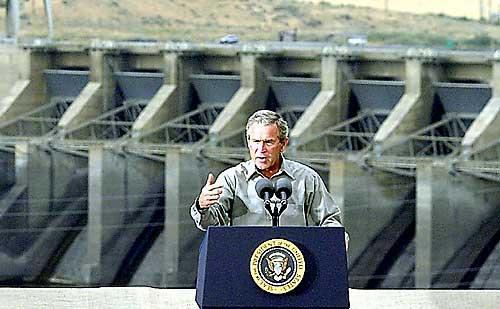forum
library
tutorial
contact

Has the Salmon Debate Changed?
by Rocky BarkerIdaho Statesman, June 21, 2009
|
the film forum library tutorial contact |

|
Has the Salmon Debate Changed?
by Rocky BarkerIdaho Statesman, June 21, 2009 |
Breaching dams seems no more likely under a new administration. But the fervor
for keeping them has died down, too, and that opens the door for discussion.
 TROUTDALE, Ore. - Jack Glass slips the net under a 25-pound spring chinook salmon just inside the "dead line" that separates the Sandy River from the Columbia.
TROUTDALE, Ore. - Jack Glass slips the net under a 25-pound spring chinook salmon just inside the "dead line" that separates the Sandy River from the Columbia.
This invisible line, marked with a sign on the shore, designates where fishing for salmon is legal this time of the year. Oregon Fish and Wildlife authorities closed the season early for salmon on the Columbia because the returns have not been as high as expected.
"This is the biggest fish I've taken so far this year," Glass said.
The "dead line" in the debate over salmon and dams is drawn between those who want to breach four dams on the Snake River to ease salmon passage and those who want to keep them - and the electricity and navigable water they provide. Glass is on the side for breaching - and the casual observer may think Glass' side is about to get a boost.
The new president was elected with the support of environmental groups. Democrats now control both houses of Congress.
Larry Craig, one of the country's leading opponents of dam breaching, has retired, and Idaho's new senior senator, Republican Mike Crapo, made regional news when he said the discussions about the future of the river have to at least broach the subject of breaching.
It was hardly support for the idea - in fact, Crapo made clear he still opposed it - but it was a big step from Craig's position that the concept should be, at best, ignored.
The issue has challenged the region since sockeye salmon were listed as endangered in 1991 and forced a clash of some of the region's key values.
And even now, with what seems like some political stars aligning for dam breaching, Glass is in the minority.
THE HARD EDGES OF THE DEBATE ARE SOFTENING
Polls in the Northwest consistently show voters oppose breaching the four dams.
The latest, released in April by RiverPartners, an industry group that opposes even discussions about dam removal, showed that two-thirds of voters oppose breaching the dams. That hasn't changed much since the group began polling, said Executive Director Terry Flores.
"If anything, there's more support for the dams than before," Flores said.
Breaching supporters like Glass - and Oregon Gov. Ted Kulongoski - know this, too, so they have turned their support to an alternative: spilling more water over the eight dams that stand between Idaho and the Pacific and drawing down the reservoirs behind those dams.
"Maybe this is something we should do before we pull out these dams," Glass said.
But while support for dam breaching may not be growing, the strength of the opposition isn't either. Changing economic trends have reduced the reliance on the dams, and the success of removal elsewhere has reduced fears of the unknown.
The Marmot Dam was removed on Oregon's Sandy River in 2007 - to the delight of Glass - and the threat of tons of sediments trapped behind the dams hurting water quality and fishing never materialized.
The Port of Lewiston and other Snake River ports served as the center of dam breaching opposition since the late 1990s. If the dams were breached and the ports closed, farmers would have fewer and costlier options for shipping.
But with farmers diversifying to more specialty crops and the decline of the timber industry, the demand for the bulk shipping offered by barges has not grown. And new industries haven't grown around the port while so much uncertainty hangs over its future.
It's not just breaching that threatens the port. Decades of water backed up behind the dams have built up layers of sediment and sand - so much that the water threatens to be too shallow for the port to work.
U.S. Army Corps of Engineers' efforts to dredge the Snake to keep the port open were stifled by a lawsuit. Now the agency is talking about raising the levees, which is very unpopular, said Jim Kluss, who owns an appliance store in Lewiston and serves on the City Council.
If people had to choose between raising the levees and breaching the dams, the vote would be close, he said.
"If we had a real strong economy at our port, you would probably have very staunch opposition," Kluss said. "But the economy has never really been delivered with the port."
"I think for the first time there's a safe space at the table for people to talk," said John Freemuth, a Boise State University political science professor.
DEMOCRATS SPLIT ON THE QUESTION OF DAMS

President George W. Bush tried to take dam breaching off the table in 2001 when his administration pushed a salmon and dam plan that didn't even mention removing the dams.
The plans, called biological opinions, say $1 billion to improve habitat and hatchery management and to control harvest - along with modifications at several dams - is enough to keep 13 endangered salmon runs "trending toward recovery." It was written with the support of all of the Columbia River Indian tribes except the Nez Perce and with support of the states of Idaho, Montana and Washington.
Republicans supported that plan, and so do Washington Democratic Sens. Patty Murray and Maria Cantwell.
"For years, the Northwest has enjoyed a collaborative ground-up process for developing solutions to protect salmon, and the court-ordered collaborative process to develop a durable comprehensive salmon plan has generated historic agreement in the region," said Ciaran Clayton, spokeswoman for Cantwell.
Murray and others say breaching the four dams would help only four of the 13 runs of salmon that are endangered, including all of Idaho's runs.
But Bill Arthur, a Sierra Club political operative in Seattle, notes that runs in eastern Washington and Oregon also are stymied by the dams. "I always try to emphasize these are not just Idaho fish," he said.
A coalition of salmon advocates - which included sport fishermen like Glass, the Nez Perce Tribe, environmentalists, the state of Oregon and commercial fishermen - has challenged the Bush plans in court, and U.S. District Judge James Redden wrote in an informal letter that he is not sure the plans are adequate under the Endangered Species Act.
The plans are now before the Obama administration, which must decide whether to accept them or rewrite them. Redden will then make his official ruling on whether they are legal.
The leading political voice against the plans is another Northwest Democrat: Kulongoski, who has stood with the Nez Perce, anglers, sporting businesses and environmentalists in the lawsuit challenging the plans.
"There seems to be political weight toward keeping the status quo, a plan that holds our hydro system harmless," said Kulongoski's natural resources advisor, Mike Carrier. "We don't think we've put forward an aggressive non-breach program that tries to do the best for fish."
ENTER THE NEW ADMINISTRATION

Obama's top environmental officials have a lot to consider.
Judge Redden is telling them that to pass Endangered Species Act muster, the dam management plans should include a contingency to breach the four lower Snake dams or draw down reservoirs on the Columbia if current measures fail to protect endangered fish. He also wants them to keep additional Snake and Columbia river water spilling over eight federal dams on the two rivers and to pay for more projects to improve spawning and estuary habitat - all on top of the more than $1 billion in added annual costs the Bush plans included to gain the support of the Indian tribes.
Obama's administration also must decide whether to follow the wishes of Murray and Cantwell, or Kulongoski, who has a plan of his own.
Kulongoski's idea meets many of Redden's concerns. He wants to spill more water over all the dams, which would help salmon smolts avoid deadly hydro turbines but would reduce power revenues. He also wants to draw down the reservoir behind John Day Dam, the largest on the Columbia below Grand Coulee, which would reduce the time it takes the smolts to pass through the slackwater. If that works, he'd like to draw down other reservoirs, as well.
The salmon advocates are hoping that the Obama administration will follow the strict - and likely costly - dictates of the Endangered Species Act. They took heart in what was said in a meeting with regional leaders last month when National Oceanic and Atmospheric Administration chief Jane Lubchenco and White House Council on Environmental Quality Chairwoman Nancy Sutley released this statement: "We share the court's concern for a final outcome that respects the law, the science and the salmon."
In its first major decision on Pacific salmon, the administration set higher standards for recovery of Sacramento River runs than were used in the Bush Snake-Columbia plans.
If Obama's officials continue with these types of decisions, that could force the region's leaders - Democrats and Republicans alike - to return to the table, said Sen. Jeff Merkley, D-Ore.
"I applaud my colleagues in Idaho for their willingness to put a variety of options on the table," said Merkley, who was working with Sen. Jim Risch, R-Idaho, on regional talks before Crapo's call for renewed discussions.
It couldn't happen soon enough for Glass, the guide and radio personality who has gone to Washington to lobby on behalf of salmon. He's hoping for the day when he doesn't have to straddle the "dead line" to legally catch salmon.
"The Columbia used to be open all year long," Glass said. "I'd love to see that again."
learn more on topics covered in the film
see the video
read the script
learn the songs
discussion forum
